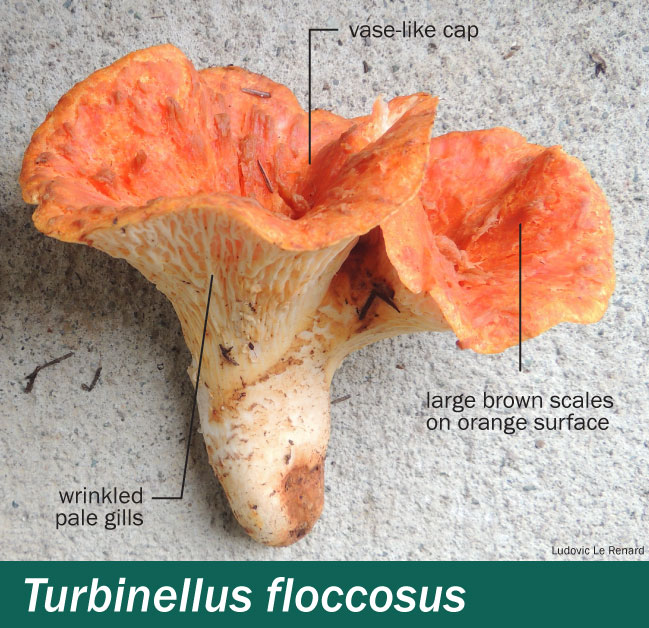Turbinellus floccosus — Scaly chanterelle, woolly chanterelle, woolly false chanterelle
Odour: Indistinct.
Cap: 5–15 cm in diameter, vase-like with a deep central depression, orange. It starts out as a dark brown cylinder with a yellow top. Distinctive orange to dark orange scales develop in concentric rings on the cap.
Gills: Instead of thin gills, scaly chanterelles have decurrent shallow, irregular wrinkled ridges, pale yellow to cream.
Stems: 8–16 cm long x 3.5–5 cm wide, vase-shaped, cream-coloured and often with yellow-orange tinges.
Ring or veil: None.
Cup: None.
Spores: 11–20 x 6–10 µm, with broad low warts.
Habitat: Solitary or in clusters, often in arcs in mixed coniferous forests. Ectomycorrhizal.
Geographical Distribution: In BC known from the coastal area, northwards into coastal Alaska, and southwards in the Cascades, and along the coast to central California. Collections reported from central or eastern North America likely represent different, unnamed species based on their genetic divergence4. The closely related Gomphus bonarii and Turbinellus kauffmanii occur in western North America. Gomphus bonarii grows in clusters at high altitudes, and has paler pinkish fruitbodies. Turbinellus kauffmanii has big pale-brown fruitbodies with very coarse scales.
Remarks: Formerly known as Gomphus floccosus.
Toxins: possibly α-tetradecylcitric acid (norcaperatic acid)8.
Symptoms: Time of onset varies and can be as late as 8–14 hours after consumption.
Treatment: Contact your regional Poison Control Centre if you or someone you know is ill after eating wild mushrooms. Poison Centres provide free, expert medical advice 24 hours a day, seven days a week. If possible, save the mushrooms or some of the leftover food containing the mushrooms to help confirm identification.
Poison Control:
British Columbia: 604-682-5050 or 1-800-567-8911.
United States (WA, OR, ID): 1-800-222-1222.

